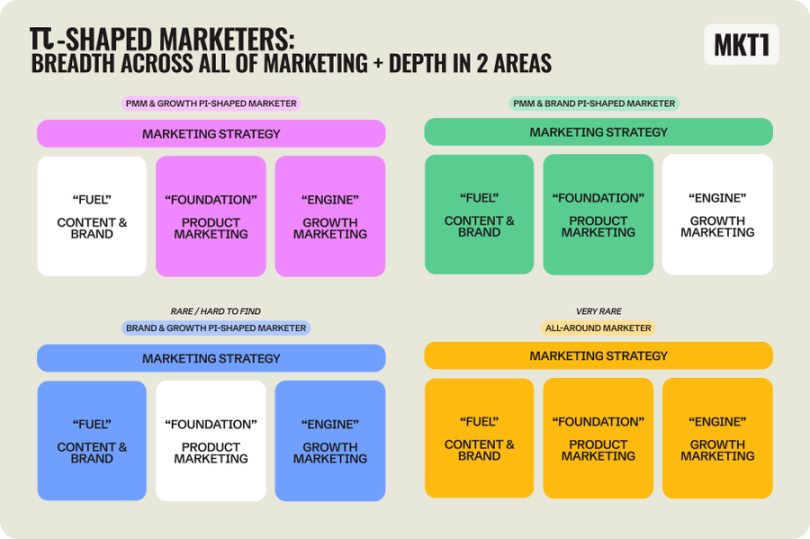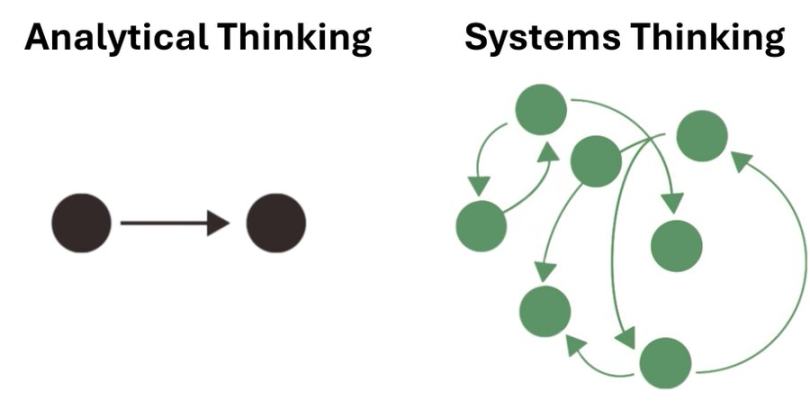When AI can optimize everything, the only important thing is to know how everything connects in the strategy.
Written by: rosie
Compiled by: AididiaoJP, Forsight News
The industry has undergone tremendous changes in the past five years.
The traditional concept of "T-shaped marketers" has vanished, stifled by artificial intelligence, automation, and many other factors.
If you still believe that a deep skill + broad knowledge = job security, then you are more likely to be replaced by large language models (LLMs) in the next 5 to 10 years. This is not about stirring emotions; it is more like predicting how replacements will unfold in the coming years.
Today's marketers are no longer the deepest experts but those who can excel at multitasking.
This is the π-shaped marketing revolution.
Framework for Predicting This Shift
@emilykramer first proposed "π-shaped marketing" at MKG, and Emily has been very accurate in her judgment of the industry's development direction.
The same pattern has emerged across various fields such as cryptocurrency, fintech, and tech startups. Companies have grown tired of hiring five disconnected experts, which is costly, and early-stage startups rarely have such funding. Even if they do, experts need coordination and clear workflows, which most startups do not yet have.
π-shaped marketing means having multiple deep areas of expertise. You can imagine it as the Greek letter π, with multiple vertical pillars of deep knowledge supported by a horizontal foundation of general marketing understanding.

The Reality of Experts Being Replaced
Companies are still hiring positions like "community manager" or "social media expert," but founders are often unclear about which type of marketer to hire first, though that is a completely different topic. If your resume states "community manager" or "social media expert," you may be phased out in 5 to 10 years.
Not because you are doing poorly. But because the work you are doing now can also be done by AI.
AI can:
Write copy better than most native speakers
Optimize ad campaigns 24/7
Analyze data faster than humans
Create high-quality content at scale (Claude excels in this area)
Automate email sequences that outperform manually written emails
But AI cannot seamlessly switch between growth marketing, ecosystem collaboration, and community building while understanding how products actually work and industry dynamics.
This still requires human judgment across multiple domains.
Why This Is Happening
Three forces make π-shaped marketing inevitable:
AI democratizes individual skills: Now every marketer can use tools that once required years of training to master, and the entry barrier for any single marketing skill has disappeared.
Role boundaries are dissolving: Growth marketers need to understand ecosystems. Community managers need to grasp token economics, social media, and growth marketing. Social media experts need experience in product marketing and KOL marketing.
Speed demands versatility
How I Discovered This
I did not plan to become a π-shaped talent; it happened because I was constantly pulled to solve problems that required multiple skills:
Pillar 1: Paid Acquisition + SEO
Running ad campaigns for projects across all platforms
Achieving organic growth through content and search optimization
Understanding which channels bring real users rather than just traffic
Pillar 2: KOL Marketing + Social Media
Managing influencer relationships and partnership deals
Building brand influence on Twitter, Telegram, and Discord
Acting as a communication translator between the tech team and retail audience
Pillar 3: Positioning + Storytelling
Explaining complex DeFi/infrastructure to the average person
Building narratives that drive adoption and investment
Positioning projects in hot markets
When these skills enhance each other, the magic happens. Your KOL campaigns improve paid positioning; your technical understanding enhances social content; your growth data shapes partnership strategies.
Effective Web3 π-shaped Combinations
In the Web3 space, many marketers are already working in a π-shaped manner, just without naming it that way, due to streamlined teams, limited budgets, and the rapid pace of development in the field. Here are some π-shaped combinations unique to Web3 that I have noticed:
Community Marketing + Product Marketing
In Web3, the community is the distribution engine for products. If you know how to position a product and activate a community (memes, incentives, feedback loops), you will become highly competitive. Many "community leads" have quietly become quasi-product marketing managers (PMMs), testing product narratives, building messaging through Twitter/Telegram, and feeding insights back to the product team.
Growth Marketing + Token Economics
Growth in Web3 is not just about ads or SEO. Token design is the growth engine; if you understand lifecycle activities and token incentives, you can design loops that retain users rather than just acquire them. Marketers running campaigns or airdrops on Galxe and Zealy are already combining growth with token mechanisms.
KOL Marketing + Community Building + Social Media
Why it works: KOLs provide initial distribution, but the community is where retention happens. Someone who knows how to secure KOL deals and build grassroots engagement will create a compound effect. By 2025, many "KOL managers" will actually be community builders who keep KOLs engaged and integrated into the community ecosystem.
Business Development (BD) + Product Marketing
Why it works: In Web3, partnerships (integrations, co-marketing, liquidity trading) are marketing. If you can secure partnerships and build them with strong positioning, you can amplify credibility and influence. Many "business development personnel" are writing copy, posting tweet threads, or drafting newsletters, quietly cultivating product marketing manager skills.
Data Analysis + Growth Marketing
Web3 provides open data. A marketer who can read on-chain analytics and run growth loops can build campaigns based on real user behavior.
Why this is happening: Teams are small, with no separate token economics and growth departments. Web3 distribution relies on incentives, community, KOLs, and integrations rather than Google and Facebook ads. Therefore, marketers are forced to merge different disciplines to survive. The most critical π-shaped combinations in Web3 revolve around community + other areas (product marketing, growth, KOL, token economics). The community is a constant, and the second pillar defines your advantage.
"Systems Thinking" Naturally Emerges
"The performance of a system depends not on the individual performance of its parts but on how they work together: how they interact, not how they act separately. Therefore, when you improve the performance of one part of a system in isolation, you may destroy the entire system." — Russell Ackoff

When you work across multiple areas of crypto marketing, you will discover patterns that experts overlook:
How community sentiment affects token prices, which in turn affects marketing budgets, thereby changing growth strategies.
How partnership announcements influence user behavior, which in turn affects conversion rates, thereby shaping campaign optimization.
How protocol updates affect user onboarding, which in turn affects retention metrics, thereby influencing community engagement.
Systems thinking is about the strategic intuition that naturally develops when you understand the multiple parts of marketing and product strategy.
Advantages of AI
AI will not replace π-shaped crypto marketers; it will only enhance them.
Experts worry that AI will take their jobs, while π-shaped marketers use AI across all capabilities:
AI generates content variations and selects based on community insights
AI analyzes on-chain data and interprets it through multiple marketing lenses
AI optimizes ad campaigns and formulates strategies based on an understanding of the ecosystem
The broader your crypto expertise, the better you can utilize AI tools across different functions.
Building Your Crypto π-shaped Skills
Step 1: Assess Your Current Depth
What crypto marketing function do you excel at? If not, choose one and dive deep.
Step 2: Identify Adjacent Skills
What problems keep arising that require different knowledge? Struggling with user acquisition? Learn paid media. Unable to explain technical concepts? Develop content skills.
Step 3: Learn Through Practice
Don’t just take classes. Look for crypto projects that force you to develop new capabilities while leveraging your existing strengths.
Step 4: Connect the Dots
Actively seek connections between skill areas. How can on-chain analysis improve community management? How can KOL experience help manage social channels?
Key Takeaways
AI cannot integrate insights across community, growth, partnerships, content, and technical marketing while understanding how crypto technology actually works.
Start building your second pillar now, then your third. Become someone who can solve complex crypto marketing problems that require expertise across multiple domains.
Because when AI can optimize everything, the only important thing is to know how everything connects in the strategy.
免责声明:本文章仅代表作者个人观点,不代表本平台的立场和观点。本文章仅供信息分享,不构成对任何人的任何投资建议。用户与作者之间的任何争议,与本平台无关。如网页中刊载的文章或图片涉及侵权,请提供相关的权利证明和身份证明发送邮件到support@aicoin.com,本平台相关工作人员将会进行核查。




